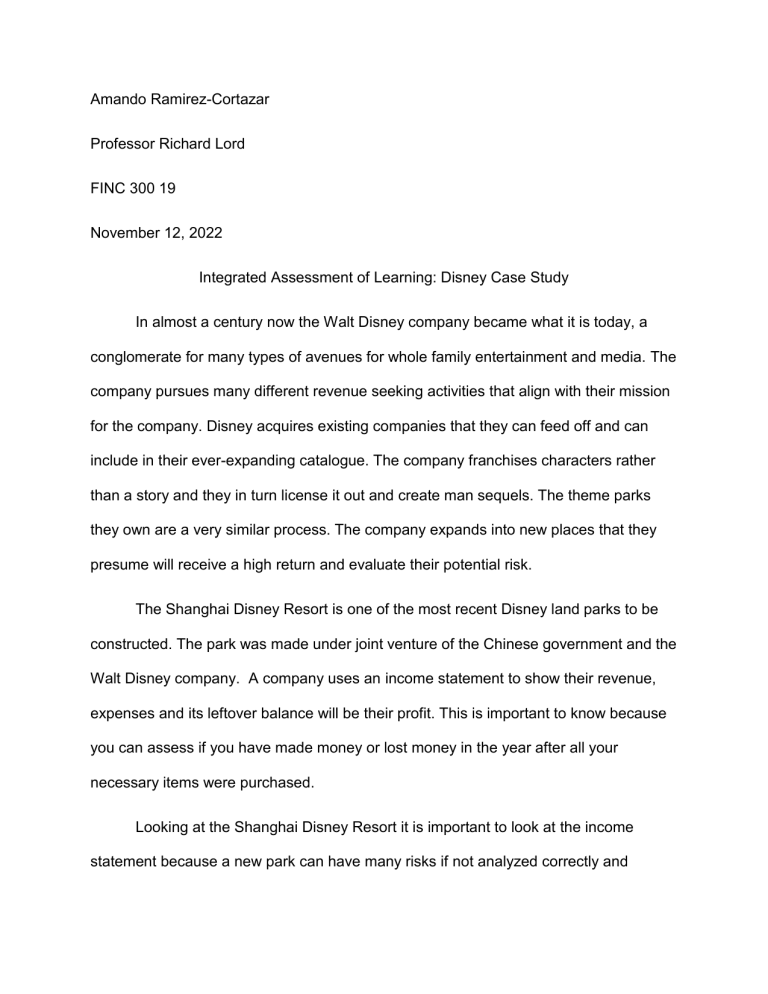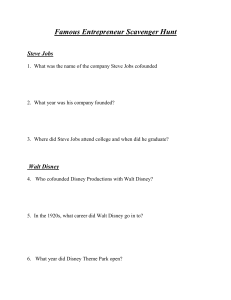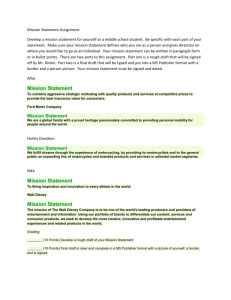
Amando Ramirez-Cortazar Professor Richard Lord FINC 300 19 November 12, 2022 Integrated Assessment of Learning: Disney Case Study In almost a century now the Walt Disney company became what it is today, a conglomerate for many types of avenues for whole family entertainment and media. The company pursues many different revenue seeking activities that align with their mission for the company. Disney acquires existing companies that they can feed off and can include in their ever-expanding catalogue. The company franchises characters rather than a story and they in turn license it out and create man sequels. The theme parks they own are a very similar process. The company expands into new places that they presume will receive a high return and evaluate their potential risk. The Shanghai Disney Resort is one of the most recent Disney land parks to be constructed. The park was made under joint venture of the Chinese government and the Walt Disney company. A company uses an income statement to show their revenue, expenses and its leftover balance will be their profit. This is important to know because you can assess if you have made money or lost money in the year after all your necessary items were purchased. Looking at the Shanghai Disney Resort it is important to look at the income statement because a new park can have many risks if not analyzed correctly and actions are not taken adequately. 3 items to look at on the Walt Disney Companies income statement include Ticket revenue, the training expense, and the land depreciation. Ticket revenue is important to look at because this will determine if enough people are going to the parks and if the prices are enough to be competitive. All 3 disciplines after the ticket price because if the total revenue is too low, management will need to be able to make the decision if making more will be enough and be adequate to solve the problem of not. The Marketing department will then in turn will need to adjust to said changes. This will need to be done quickly and efficiently. The operation management department will need to put resources so as not to lose focus on the customers. The training expense will need to be important, especially in this case. The team up to this point is non-existent, major hiring will need to be done and people will be transitioned to this branch. Training will ensure quality workers arise. This is a necessary expense that will pay off in the long run. The operation management part of the company must create a process design that the theme park will run off and use. The marketing department will need to do some recruitment marketing to get candidates that can bring some sort of skill to the company. This process must be quick to not have an inefficient business that is at mercy of the active workers. The management team will need to work with these new workers and get them up to speed quickly in the company and motivate them to build a culture of excellence. The final item on the income statement that the new Shanghai location should look at is the land depreciation expense. The depreciation expense differs from the Accumulated Depreciation that exists on the balance sheet. The Accumulated depreciation is the total value of an item can be depreciated to at the end of its life. The Walt Disney company would benefit greatly using the depreciation curve so they can write off the value of the business over many years rather than just off the beginning. This will affect management because it will lower or increase a company’s profit which they get taxed on. The same profit is a point of contention on stock price as well which high-ranking officials get paid on. This goes the same for many of these officials in a lot of departments like operating management and marketing. So not only do their salaries get affected but so do their working cash flow which they may use for research and development or testing of new products. Three ratios that Disney should look at that will impact the opening of a new theme park would include the Revenue per total acre, debt to equity ratio and the revenue per operating expenses. I will be looking at data from annual revenue for 2021. The debt-to-equity ratio is 0.3429, the revenue to operating expenses is 1.0466 and the Revenue/Acre is about 61.3 million dollars/ acre. A competitor I chose in the same space would be six flags, their debt-to equity ratio is -2.474, their revenue to operating expenses are 2.313. These ratios are important to look at as a new company because a company with too much debt will be one that will be much more likely to fail because at a certain point there is too much risk. The revenue to operating expense is important because if a company has to much expense they can consider directly cutting back on cost an they can get more investors in. The revenue to acre is important because it is important to see if you are using your land efficiently. The Walt Disney Company makes it seem that they are a family-oriented company that cares for whole family entertainment, which I do agree with to a certain point. Thou the company is gilded as well, covering up serious scandals of top executives at the company. Violations of ethics and integrity have occurred and once broken affect not only the company but investors, customers, employees, and overall financial performance. The investor of a company hedges on the success of a company and any malpractice like this will result in bad public relations which people determine whether to buy or not buy stock on. If many sell the stock price goes down since it become reality available for cheaper. Investors with deep pockets could lose a fortune by it dropping in value. Customers will be affected through public scrutiny; this comes from supporting businesses that do nothing in this scandal. They will need to turn to their competitors and feel alienated by a company they build a bond with. Employees in this case tend to feel the most, that is in harassment cases they are the ones that are on the end of it. This has psychological issues on some, but they are at risk of losing their jobs and lively hood. Other employees might leave if the situation gets bad, which is no easy task to relocate and find a new job. Financially the company suffers for all the reasons stated above. Less people in parks means less ticket sales, food, transportation etc. Along with fewer than willing investors and high turnover the company will need to change quickly before it is too late. We see example of this in the case study, The Walt Disney Company: Sexual Harassment and controversies on social media, where situations where not handled to the best of there abilities. John Lasseter, the Chief Creative Officer of Pixar Studios who now not currently at the company but allowed him to sexually harass female colleagues. This is not an ethically responsible way of letting your business run. Lasseter who oversaw production of the first CGI animated film, Toy Story and had history of bringing in huge box office numbers and the company was him as too valuable for some time. They decided not to fire him, and it was he who decided to just take a leave of absence. The company employed both directors James Gunn and Rian Johnson as well. Both men where also recently held to a double standard where both men made comments on social media, and one got fired while the other nothing was said. This is not ethical to allow for special treatment of certain executives while others you publicly denounce any times for a statement years ago.



